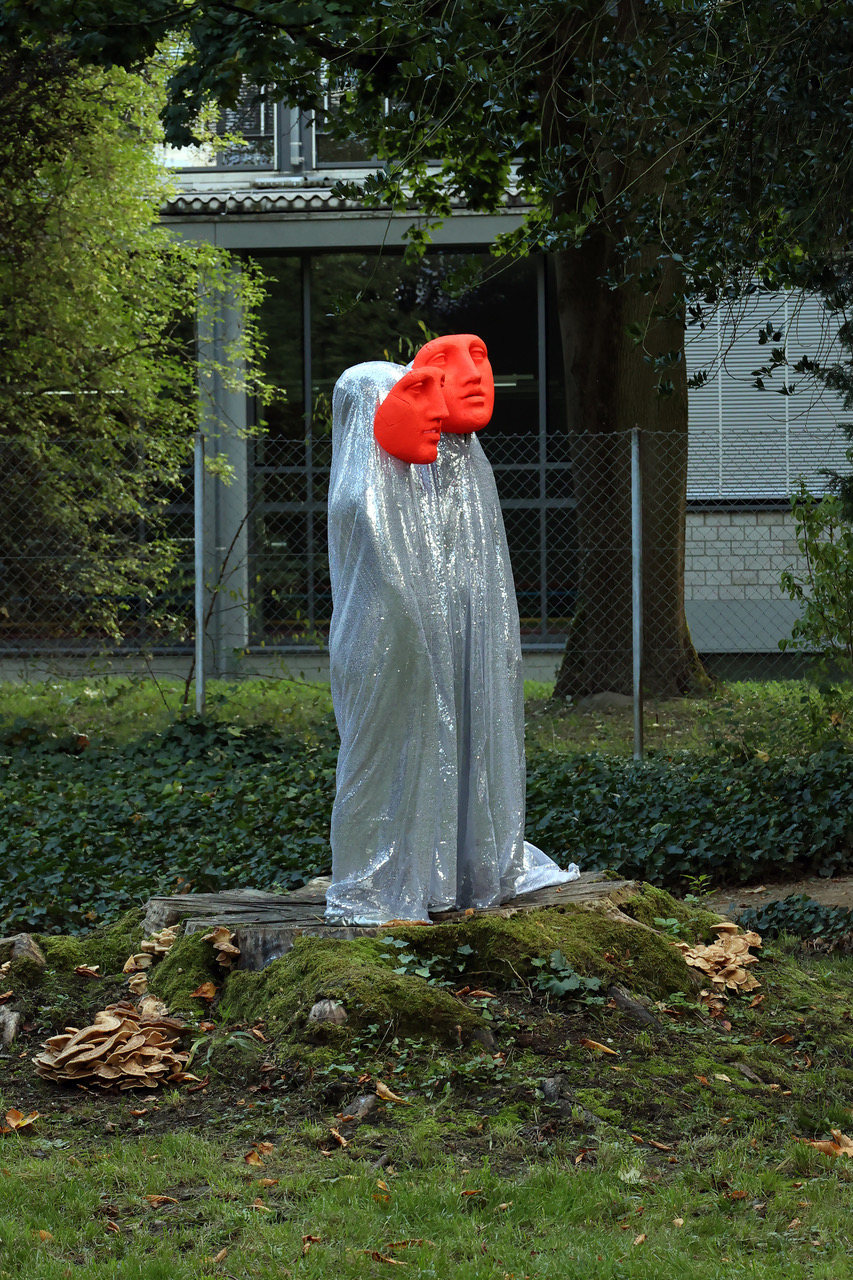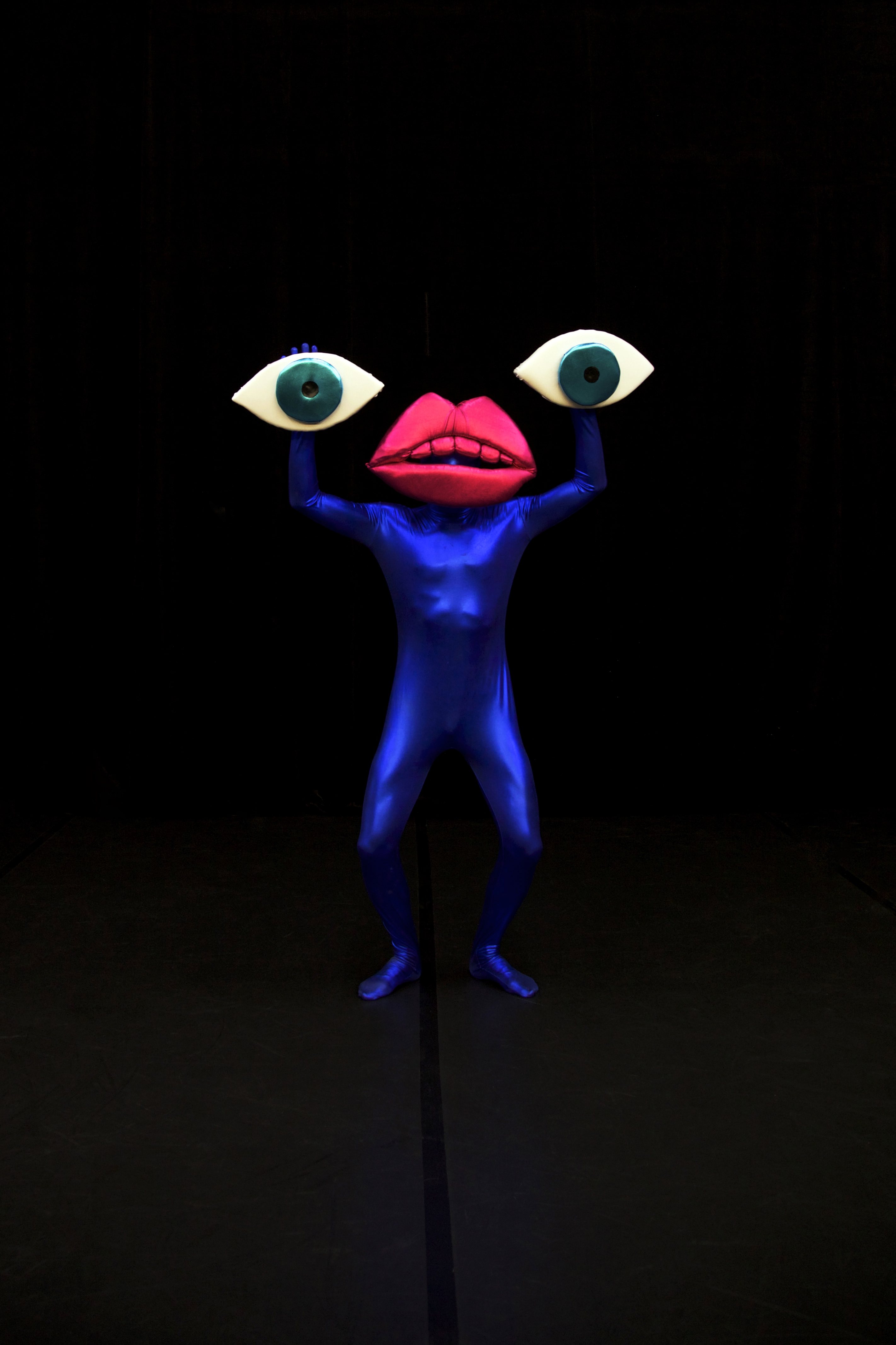︎Dennis
︎Before it was water
︎Green Room
(all images are courtesy of the artist)
/Dennis (2021-ongoing)
![]()
/Dennis (2021-ongoing)
![]()
Costumes: lycra, glitter fabric; resin masks
Performers: Alix Debraine and Julie Monot
Pictures are by Guillaume Musset
Two masked and ghostly characters inhabit the symmetrical French garden at Sandgrube. Their presence and identity
clearly refer to Greek statuary, a copy of the young and androgynous Dionysus that can be admired in the Capitoline
Museum in Rome. This ambiguous representation historically migrated by mistake and was eventually attributed to
Ariadne, and so changed gender over time.
![]()
![]()
![]()
![]()
The performance was presented on the occasion of the project dedicated to
performances in public space “Die Raum”, initiated by the Department of Culture and
curated by Kadiatou Diallo and Madeleine Amsler.
It showed 12 artistic approaches and negotiations by women - artists from
Basel and Switzerland, visitors, residents and rebels.
/Before it was water (2019)
When she was young, Monot was told that the carpet she like to lie on was actually a breeding ground for microscopic creatures of all kinds. Like many kids this arguably was her first encounter with the idea of invisible life. This memory led her to look into single-celled organisms, and she became interested in how the evolution of unicellular life marked a crucial turn in the evolution of life on Earth.
Before it was water is a hand-tufted kimono with motifs inspired on various types of single-cell organisms.
![]()
Two masked and ghostly characters inhabit the symmetrical French garden at Sandgrube. Their presence and identity clearly refer to Greek statuary, a copy of the young and androgynous Dionysus that can be admired in the Capitoline Museum in Rome. This ambiguous representation historically migrated by mistake and was eventually attributed to Ariadne, and so changed gender over time.
![]()
![]()
![]()
![]()
The performance was presented on the occasion of the project dedicated to
performances in public space “Die Raum”, initiated by the Department of Culture and
curated by Kadiatou Diallo and Madeleine Amsler.
It showed 12 artistic approaches and negotiations by women - artists from
Basel and Switzerland, visitors, residents and rebels.
/Before it was water (2019)


When she was young, Monot was told that the carpet she like to lie on was actually a breeding ground for microscopic creatures of all kinds. Like many kids this arguably was her first encounter with the idea of invisible life. This memory led her to look into single-celled organisms, and she became interested in how the evolution of unicellular life marked a crucial turn in the evolution of life on Earth.
Before it was water is a hand-tufted kimono with motifs inspired on various types of single-cell organisms.

Wool, cotton, synthetic latex
Folded on a metal bar hanging from the ceiling, the work was activated during the opening reception of
the exhibition BODY SPLITS at SALTS by a performer.
This short incarnation, like in many other of Monot’s works, bridges her work with sculpture to a more performative and time-based practice. Kimonos are interesting garments for the artist insofar as they provide vast surfaces whose shape remains unchanged, regardless of the body shape, the age and the gender of the person who is wearing it.
//Green Room (2018)
(17-26.01.2018, Arsenic Performing Arts Center, Lausanne, Switzerland; curated by Elise Lammer for Alpina Huus)
The versatile aspect of a green room, which sits between the private and public realms, and the transitional quality of the colour is precisely what artist Julie Monot explored in her exhibition GREEN ROOM
Transition sits in every element of the project, for which she produced over 15 anthropomorphic sculptures, as well as a series of scenographic devices.
![]() BOCA ︎
BOCA ︎
![]() DENNIS ︎
DENNIS ︎
![]() GET DRESSED ︎
GET DRESSED ︎
![]() GOLDEN BOY ︎
GOLDEN BOY ︎
![]() HAMAC ︎
HAMAC ︎
![]() HANDY ︎
HANDY ︎
![]() HOME ︎
HOME ︎
![]() HON ︎
HON ︎
![]() L’AVENIR DES STATUES ︎
L’AVENIR DES STATUES ︎
![]() LE GRAND OBJET ︎
LE GRAND OBJET ︎
![]() MOP ︎
MOP ︎
![]() MUSE ENDORMIE ︎
MUSE ENDORMIE ︎
![]() NATURAE ︎
NATURAE ︎
![]() PIERROT ︎
PIERROT ︎
![]() SCULPTURE IS NOT DEAD ︎
SCULPTURE IS NOT DEAD ︎
![]() SO STONE ︎
SO STONE ︎
![]() SUNSET ︎
SUNSET ︎
![]() WODWO ︎
WODWO ︎
For Monot, transition is often a synonym of transformation, a topic she’s been exploring through numerous installations, videos and performances since 2013. In GREEN ROOM transformation starts on the opening night, with a 4-hour performance during which each artwork is brought to life by performers, and by means of a sequence of lights and smoke effects. The artist has developed a light pattern that evolves from white fluorescent light, typical of a contemporary exhibition space, to a more dramatic, cinematic green over the course of a 20-minute cycle.
![]()
As a result, the green light dramatically affects the perception of colours, visually transforming all the elements and characters of the exhibition. From a psychological perspective, it’s been observed that green light can enhance concentration and tends to create a state of alertness.
On the other hand, an over exposure to white florescent light—the most common light source within corporate environments—can induce stress and paranoia. At the end of the 4-hour performance, everything is back into place, and yet each sculpture carries the invisible traces of its recent activation, giving its final form to the exhibition.
![]()
![]()
![]()
![]()
![]()
![]()
![]()
Forming a retrospective constellation, the 17 sculptures all emerge from Monot’s eclectic repertoire and biography, with quotes taken from modern art history, Pop music, classical literature, and fashion, to name only but a few. Not without humour, high and low cultures are merged together, contributing to a non-hierarchical vision of collective memory.
![]()
To learn more about Julie Monot, you can also read a curated interview by LOTTOZERO ︎︎︎ here
Julie Monot graduated with a BA in Visual Arts at the HEAD of Geneva (2017) and an MA in Visual Arts at ECAL Lausanne (2019). Her artistic practice moves between different mediums such as performances, installations, sculptures and videos. Her research focuses on, among other things, the borderline zones of bodily exteriority and its modes of representation. The notion of the figure is part of her specific interests, for its polysemic and vigour characteristics, but above all because it allows a figurative and critical space on our social constructions. Accessories of transformation, costumes, prosthesis, corporal "furnitures” and objects related to this praxis are part of her daily reflections.
Folded on a metal bar hanging from the ceiling, the work was activated during the opening reception of
the exhibition BODY SPLITS at SALTS by a performer.
This short incarnation, like in many other of Monot’s works, bridges her work with sculpture to a more performative and time-based practice. Kimonos are interesting garments for the artist insofar as they provide vast surfaces whose shape remains unchanged, regardless of the body shape, the age and the gender of the person who is wearing it.
//Green Room (2018)
(17-26.01.2018, Arsenic Performing Arts Center, Lausanne, Switzerland; curated by Elise Lammer for Alpina Huus)
The versatile aspect of a green room, which sits between the private and public realms, and the transitional quality of the colour is precisely what artist Julie Monot explored in her exhibition GREEN ROOM
Transition sits in every element of the project, for which she produced over 15 anthropomorphic sculptures, as well as a series of scenographic devices.
 BOCA ︎
BOCA ︎ DENNIS ︎
DENNIS ︎ GET DRESSED ︎
GET DRESSED ︎ GOLDEN BOY ︎
GOLDEN BOY ︎ HAMAC ︎
HAMAC ︎ HANDY ︎
HANDY ︎ HOME ︎
HOME ︎ HON ︎
HON ︎ L’AVENIR DES STATUES ︎
L’AVENIR DES STATUES ︎ LE GRAND OBJET ︎
LE GRAND OBJET ︎ MOP ︎
MOP ︎ MUSE ENDORMIE ︎
MUSE ENDORMIE ︎ NATURAE ︎
NATURAE ︎ PIERROT ︎
PIERROT ︎ SCULPTURE IS NOT DEAD ︎
SCULPTURE IS NOT DEAD ︎
 SO STONE ︎
SO STONE ︎ SUNSET ︎
SUNSET ︎
 WODWO ︎
WODWO ︎
For Monot, transition is often a synonym of transformation, a topic she’s been exploring through numerous installations, videos and performances since 2013. In GREEN ROOM transformation starts on the opening night, with a 4-hour performance during which each artwork is brought to life by performers, and by means of a sequence of lights and smoke effects. The artist has developed a light pattern that evolves from white fluorescent light, typical of a contemporary exhibition space, to a more dramatic, cinematic green over the course of a 20-minute cycle.

As a result, the green light dramatically affects the perception of colours, visually transforming all the elements and characters of the exhibition. From a psychological perspective, it’s been observed that green light can enhance concentration and tends to create a state of alertness.
On the other hand, an over exposure to white florescent light—the most common light source within corporate environments—can induce stress and paranoia. At the end of the 4-hour performance, everything is back into place, and yet each sculpture carries the invisible traces of its recent activation, giving its final form to the exhibition.







Forming a retrospective constellation, the 17 sculptures all emerge from Monot’s eclectic repertoire and biography, with quotes taken from modern art history, Pop music, classical literature, and fashion, to name only but a few. Not without humour, high and low cultures are merged together, contributing to a non-hierarchical vision of collective memory.



